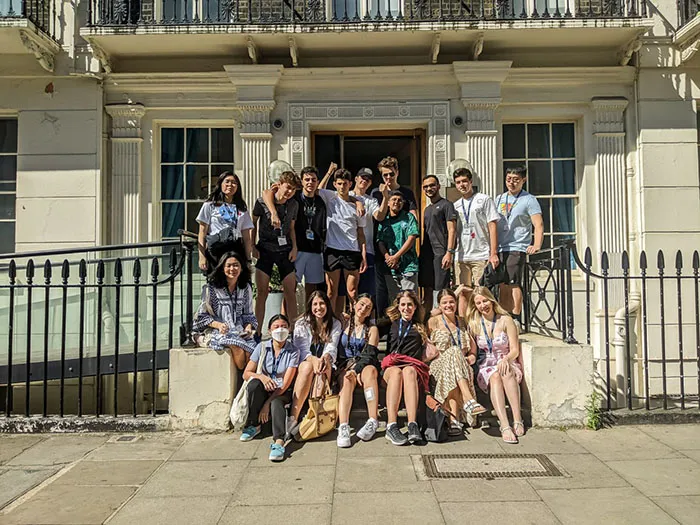Cambridge invites you into a city of soaring spires, quiet courtyards, and ancient stone that glows at golden hour. You’ll find the best libraries in Cambridge woven into this beauty, shaped by centuries of craft and academic tradition.
These libraries are more than quiet rooms; they’re living parts of the university’s history and community.
During our Cambridge Summer School, you’ll explore these remarkable libraries, where you can study, reflect, and connect with your peers in inspiring surroundings.
Let’s step into the study environments that capture the spirit and rhythm of this extraordinary city.
The Bodleian of Cambridge: University Library Highlights
For more than six centuries, figures like Sir Isaac Newton, Sylvia Plath, Stephen Hawking, and Zadie Smith have crossed these thresholds in search of ideas and inspiration. Today, you walk the same path.
The Cambridge University Library is the city’s central research hub, combining tradition, scale, and a quiet sense of discovery. It’s millions of books, rare manuscripts, and extensive digital archives that support every academic field with remarkable depth and range.
You’ll see how the building pairs architectural strength with thoughtful design. Tall windows brighten the halls, long tables support steady work, and the quiet atmosphere helps you focus deeply.
Beyond its architecture, the library is home to collections found almost nowhere else. You can encounter rare fragments from the Cairo Genizah, explore Charles Darwin’s original working papers and notebooks, view one of the earliest copies of the Gutenberg Bible, or examine parts of the Codex Zacynthius, a sixth-century Greek New Testament manuscript.
Each area creates a different rhythm. In particular, the North Front Reading Room feels formal and contemplative, while modern study zones provide space for flexible, relaxed work. Together, they reveal Cambridge’s balance of heritage and innovation.
Because of this atmosphere, many visitors find their first visit unexpectedly moving. The scale of the collections and the quiet rooms give you a sense of belonging to a long academic tradition.
During our Cambridge Summer School, you’ll study in these inspiring rooms, connect with your peers, and feel part of a living scholarly tradition. You’ll often experience the same surroundings that real university participants use every day. There’s something quietly inspiring about working in rooms where so many ideas have taken shape over the centuries.
Iconic College Libraries Worth Visiting
Aside from the Cambridge University Library, the college libraries offer historic architecture, intimate study spaces, and rich academic character.
With that in mind, here are three iconic college libraries you’ll want to explore.
1. Trinity College Library
To start, Trinity College Library stands out for its grandeur, calm atmosphere, and deep academic heritage. Located within the historic grounds of Trinity College, founded in 1546, it carries centuries of scholarship you feel upon entering.
The library sits just off Trinity’s Great Court, placing it at the centre of one of Cambridge’s iconic college settings. Its historic reading room is lined with tall bookcases holding leather-bound volumes, some dating back to the seventeenth century. Large mullioned windows soften the room with gentle light, creating warm, balanced surroundings ideal for reflective study.
Its high, finely detailed plaster ceiling, arranged in elegant rectangular panels, gives the room a bright and uplifting sense of space. Tall columns and arches frame the central aisle, while carved bookcases and marble busts create a rhythm that guides your eye.
The symmetry, light, and crisp architectural lines create a harmony that sets this library apart in Cambridge.
Trinity’s uniqueness becomes even clearer in its collection. The library preserves treasures such as the twelfth-century Eadwine Psalter and the fifteenth-century Trinity Carol Roll, manuscripts that reveal its long relationship with art, music, and scholarly tradition. It’s a library that rewards slow, curious exploration.
2. St John’s College Library
By contrast, St John’s College Library offers a quieter, more contemplative atmosphere, shaped by centuries of learning and the college’s strong intellectual identity. Located within St John’s historic grounds, it feels like a calm retreat from the busier parts of Cambridge.
Moreover, its Old Library, dating back to the early seventeenth century, is one of the most distinctive heritage spaces in the university. The room preserves original oak shelving, carved book presses, and warm timber interiors, creating an authenticity few Cambridge libraries match.
The library’s Jacobean architecture adds another layer of character. Stone-framed windows, wooden beams, and long reading bays create an atmosphere that feels timeless yet welcoming.
Its collections include medieval manuscripts, early printed books, and scientific works that reveal how scholarship evolved over the centuries. You can imagine Paul Dirac or William Wilberforce finding inspiration in such surroundings.
What makes this library worth visiting is its stillness. It offers a peaceful, immersive space that encourages slow reading and thoughtful reflection.
3. King’s College Library
King’s College Library combines historic charm with a bright, welcoming atmosphere that feels distinctly different from other Cambridge libraries. Set within King’s College, founded in 1441, it sits near the Chapel and shares its quiet sense of splendour.
The reading rooms balance traditional woodwork with lighter, open spaces. Sunlight pours through tall windows, illuminating shelves and creating an environment that feels calm, spacious, and ideal for focused study.
The library holds over 36,000 rare books and manuscripts spanning ten centuries, forming one of the university’s widest collections.
Among its special holdings are the personal libraries of John Maynard Keynes, the influential economist, and George Thackeray, a renowned classical scholar and bibliophile.
What makes this library unique is its blend of openness and historical depth. It feels less formal than older spaces, yet each shelf reflects centuries of artistic, musical, and scholarly tradition.
These libraries offer more than beautiful surroundings. They show how architecture, history, and daily study come together in each college’s identity.
Participants in our Architecture Summer School in Cambridge often appreciate these spaces for their design, structure, and cultural value, discovering how the details of each library shape the way people think, read, and connect.
Modern and Public Study Spaces in Cambridge
At the same time, Cambridge balances its historic libraries with modern study spaces that feel open, accessible, and designed for today’s learning needs. These places give you flexible environments where you can choose your pace and find a study rhythm that suits you.
The Cambridge Central Library, located in the Grand Arcade, offers bright reading rooms, wide tables, and a relaxed atmosphere. With photocopiers, printers, computers, free Wi-Fi, and hireable rooms, it stays practical for every kind of study or work.
At the same time, quiet zones support focused study, while open seating areas give you room to read comfortably. Its central location and extended hours make it a popular choice for independent learners.
The University’s digital learning hubs provide a different pace. You’ll find computer suites, flexible desks, and collaborative areas with screens and digital tools for research and presentations. Many hubs include bookable study rooms for private or group work.
These modern spaces complement Cambridge’s historic libraries by giving you comfort and convenience for contemporary study.
Participants in our Cambridge History Summer School often enjoy this balance. They can explore centuries-old texts one day and use advanced digital resources the next, gaining a sense of learning’s evolution.
Join the Immerse Education 2025 Essay Competition
Follow the instructions to write and submit your best essay for a chance to be awarded a 100% scholarship.

Library Etiquette and Cambridge Study Culture
Cambridge’s libraries work best when everyone respects the spaces, the collections, and the shared focus they create. These places rely on calm behaviour and thoughtful study habits that help every visitor settle into a steady rhythm.
While rules differ slightly between libraries, here are some common guidelines you should follow in all of them.
- Register for a reader card: Register online or in person with ID to access borrowing and library services.
- Carry your access card: Cambridge libraries usually require a valid ID or membership card at entry, helping staff confirm access quickly and keep study spaces secure and well managed.
- Respect the Code of Conduct: Libraries expect courtesy, calm behaviour, and cooperation, creating study environments where everyone feels welcome, focused, and supported from the moment they enter.
- Choose quiet zones: Many libraries divide their spaces, allowing you to select areas suited to focused work, relaxed reading, or reflective study without disturbing those nearby.
- Respect silent reading rooms: These historic Cambridge spaces require complete quiet, supporting deep focus and protecting the peaceful atmosphere valued by generations of readers.
- Share long tables politely: Arrange your belongings neatly, leave room for others, and maintain a considerate presence that helps everyone study comfortably and confidently.
- Keep phones silent: Switch devices to silent mode and take calls outside, particularly in older rooms where even soft noise can disrupt the calm.
- Use digital facilities quietly: Computers, Wi-Fi, and personal devices are available throughout most libraries, but you must work gently to maintain a respectful atmosphere.
- Follow reference-only rules: Many rare or pre-1900 items must stay on-site for preservation, so handle them carefully and return them exactly as directed.
- Know borrowing limits: Loan privileges vary by user type, and visitors usually receive reading-room access only, so checking your category early helps you plan your study effectively.
Experiencing Cambridge Through Its Libraries
Cambridge’s libraries reveal how the city balances long-standing academic traditions with thoughtful modern innovation. They show you how history and contemporary study coexist in one inspiring place.
These spaces invite calm focus, curiosity, and reflection, whether you find yourself in a centuries-old reading room or a bright digital hub.
You’ll see why the best libraries in Cambridge continue to shape how people think, learn, and connect across generations.
Through our Cambridge Summer School programmes, like the Architecture Summer School in Cambridge, or the Cambridge History Summer School, you can explore these iconic study spaces and experience the intellectual heart of the city for yourself.




















